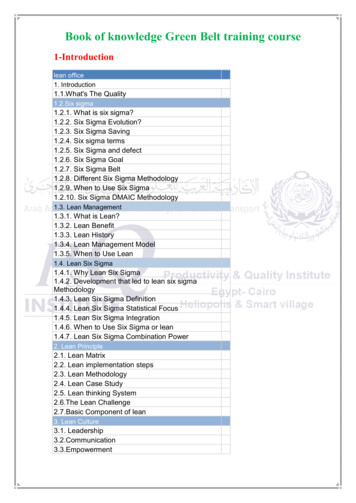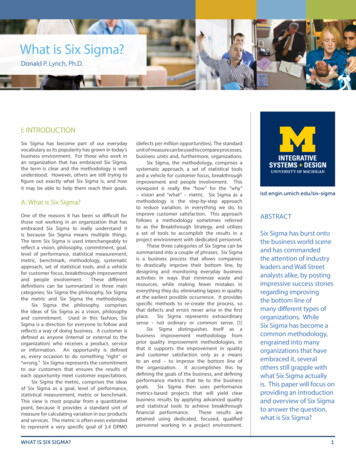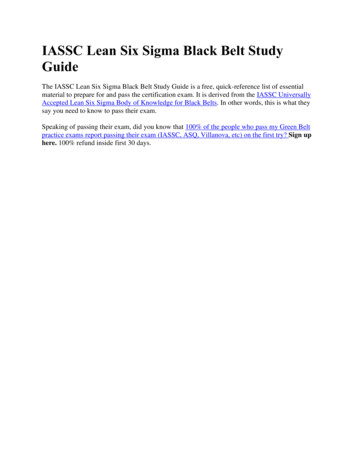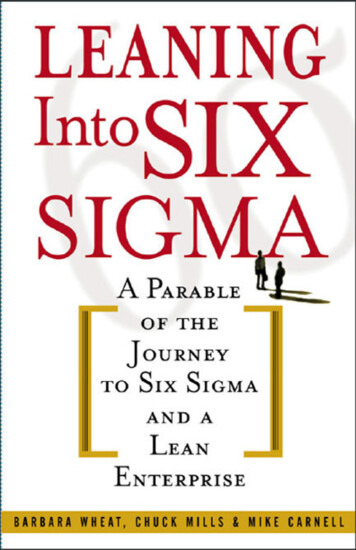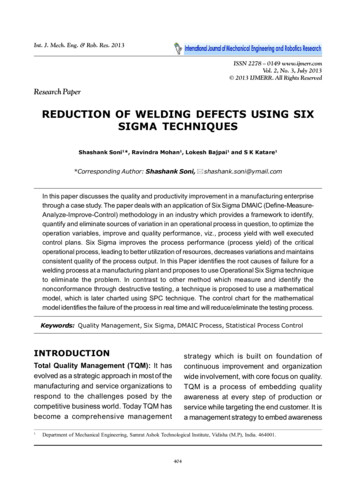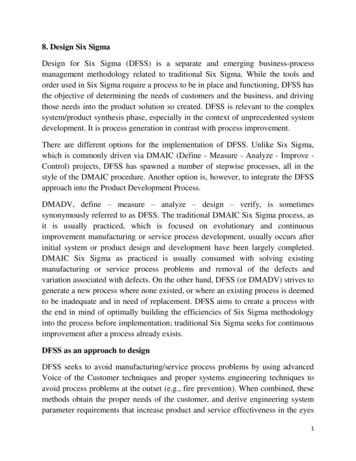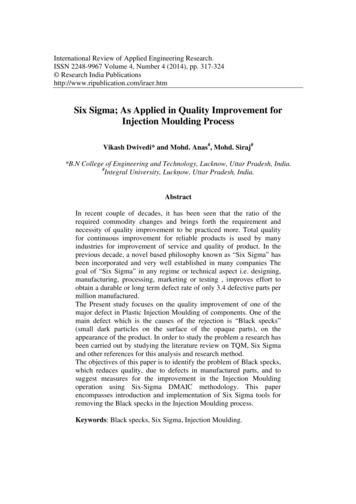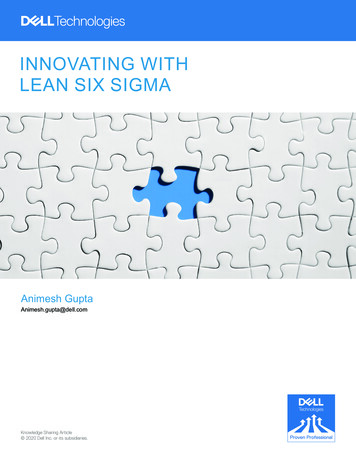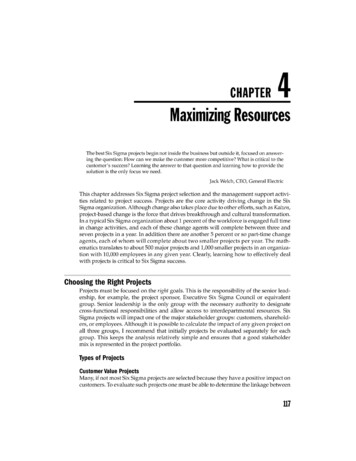
Transcription
CHAPTER4Maximizing ResourcesThe best Six Sigma projects begin not inside the business but outside it, focused on answering the question: How can we make the customer more competitive? What is critical to thecustomer's success? Leaming the answer to that question and leaming how to provide thesolution is the only focus we need.Jack Welch, CEO, General ElectricThis chapter addresses Six Sigma project selection and the management support activities related to project success. Projects are the core activity driving change in the SixSigma organization. Although change also takes place due to other efforts, such as Kaizen,project-based change is the force that drives breakthrough and cultural transformation.In a typical Six Sigma organization about 1 percent of the workforce is engaged full timein change activities, and each of these change agents will complete between three andseven projects in a year. In addition there are another 5 percent or so part-time changeagents, each of whom will complete about two smaller projects per year. The mathematics translates to about 500 major projects and 1,000 smaller projects in an organization with 10,000 employees in any given year. Clearly, learning how to effectively dealwith projects is critical to Six Sigma success.Choosing the Right ProjectsProjects must be focused on the right goals. This is the responsibility of the senior leadership, for example, the project sponsor, Executive Six Sigma Councilor equivalentgroup. Senior leadership is the only group with the necessary authority to designatecross-functional responsibilities and allow access to interdepartmental resources. SixSigma projects will impact one of the major stakeholder groups: customers, shareholders, or employees. Although it is possible to calculate the impact of any given project onall three groups, I recommend that initially projects be evaluated separately for eachgroup. This keeps the analysis relatively simple and ensures that a good stakeholdermix is represented in the project portfolio.Types of ProjectsCustomer Value ProjectsMany, if not most Six Sigma projects are selected because they have a positive impact oncustomers. To evaluate such projects one must be able to determine the linkage between117
118Chapter Fourbusiness processes and customer-perceived value. Chapter 2 discussed how to createorganizations that are customer-driven, which is essentiaL Customer-driven organizations,especially process enterprises, focus on customer value as a matter of routine. Thisfocus will generate many Six Sigma customer value projects in the course of strategydeployment. However, in addition to the strategy-based linkage of Six Sigma projectsdescribed in Chap. 2, there is also a need to use customer demands directly to generatefocused Six Sigma projects. The techniques for obtaining this linkage are the same asthose used in Chap. 2. The difference is that the focus here is not on strategy deployment or budgeting, but on Six Sigma improvement projects focused on specific customer demands.Learning what customers value is primarily determined by firsthand contact withcustomers through customer focus groups, interviews, surveys, etc. The connectionbetween customer-perceived value and business processes, or "customer valuestreams," is established through business process mapping (see Chap. 6 and 7) andquality function deployment (QFD). The Executive Six Sigma Council and project sponsors should carefully review the results of these efforts to locate the "lever points"where Six Sigma projects will have the greatest impact on customer value.Shareholder Value ProjectsSix Sigma provides a "double-whammy" by addressing both efficiency and revenues.Revenue is impacted by improving the customer value proposition, which allowsorganizations to charge premium prices for superior quality, or to keep prices competitive and increase sales volume and market share due to superior quality. Improvedefficiency is achieved by reducing the cost of poor quality, reducing cycle time, oreliminating waste in business processes. To determine which Six Sigma projectsaddress the issue of business process efficiency evaluate the high-level business process maps (including SIPOC) and flow charts.Other Six Sigma ProjectsSome Six Sigma projects address intangibles, such as employee morale, regulatory concerns, or environmental issues. These projects can be just as important as those whichaddress customer or shareholder value.Analyzing Project CandidatesYou now have a list of candidate Six Sigma projects. Assuming that the organization haslimited resources, the next task is to select a subset of these projects to fund and staff.Projects cost money, take time, and disrupt normal operations and standard routines. For these reasons projects designed to improve processes should be limited toprocesses that are important to the enterprise. Furthermore, projects should be undertaken only when success is highly likely. Feasibility is determined by considering thescope and cost of a project and the support it receives from the process owner. In thissection a number of techniques and approaches are presented to help identify thoseprojects that will be chosen for Six Sigma.Benefit-Cost AnalysisBenefit-cost analysis can be as elaborate or as simple as the magnitude of the projectexpenditures demands. The Six Sigma manager is advised that most such analyses are
Ma x i mi z i ng Res 0 U r c e seasier to "sell" to senior management if done by (or reviewed and approved by) expertsin the finance and accounting department. The plain fact is that the finance departmenthas credibility in estimating cost and benefit that the Six Sigma department, and anyother department, lacks. The best approach is to get the finance department to conductthe benefit-cost analysis with support from the other departments involved in the project.We will provide an overview of some principles and techniques that are useful in benefitcost analysis.A fundamental problem with performing benefit-cost analysis is that, in general,it is easier to accurately estimate costs than benefits. Costs can usually be quantifiedin fairly precise terms in a budget. Costs are claims on resources the firm already has.In contrast, benefits are merely predictions of future events, which mayor may notactually occur. Also, benefits are often stated in units other than dollars, making thecomparison of cost and benefit problematic. The problem is especially acute wherequality improvement projects are concerned. For example, a proposed project mayinvolve placing additional staff on a customer "hot line." The cost is easy to compute:X employees at a salary of Y each, equipment, office space, supervision, etc. Thebenefit is much more difficult to determine. Perhaps data indicate that average timeon hold will be improved, but the amount of the improvement and the probabilitythat it will occur are speculations. Even if the time-on-hold improvement were precise, the impact on customer satisfaction would be an estimate. The associationbetween customer satisfaction and revenues is yet another estimate. Despite thesedifficulties, reasonable cause-and-effect linkages can be established to form the basisfor benefit-cost analysis. To compensate for the uncertainties of estimating benefits, itmakes sense to demand a relatively high ratio of benefit to cost. For example, it is notunusual to have senior leadership demand a ROI of 100% in the first year on a SixSigma project. Rather than becoming distressed at this "injustice," the Black Beltshould realize that such demands are a response to the inherent difficulties in quantifying benefits.Types of SavingsThe accounting or finance department should formally define the different categories ofsavings. Savings are typically placed in categories such as:Hard savings are actual reductions in dollars now being spent, such as reduced budgets, fewer employees, reduction of prices paid on purchasing contracts, and so on.Hard savings can be used to lower prices, change bid models, increase profits, or forother purposes where a high degree of confidence in the benefit is required.Soft savings are projected reductions that should result from the project. For example, savings from less inventory, reduced testing, lower cycle times, improved yields,lower rework rates, and reduced scrap.It is important that savings be integrated into the business systems of the organization. If the institutional framework doesn't change, the savings could eventually be lost.For example, if a Six Sigma project improves a process yield, be sure the MRP system'scalculations reflect the new yields.A System for Assessing Six Sigma ProjectsAssessing Six Sigma projects is an art as well as a science. It is also critical to the successof Six Sigma, and to the individual Black Belt. Far too many Black Belts fail because they119
120Chap te r F0 urare not discriminating enough in their selection of projects. If project selection is systematically sloppy, the entire Six Sigma effort can fail.The approach offered here is quantitative in the sense that numbers are determined and an overall project score calculated. It is subjective to the degree it requiresinterpretation of the situation, estimated probabilities, costs, and commitments.However, the rigor of completing this assessment process allows for better judgments regarding projects. The numbers (weights, scores, acceptable length of projects, dollar cutoffs, etc.) are recommendations which can and should be replaced bythe organization's leadership to reflect organizational priorities. The scale rangesfrom a to 9 for each criterion, and the weights sum to LOa, so the highest possibleweighted score for a project is 9.The Six Sigma department or Process Excellence function can compile summarylistings of project candidates from these assessments. Sorting the list in descendingorder provides a guide to the final decision as to which projects to pursue. Each BlackBelt or Green Belt will probably have their own list, which can also be sorted and usedto guide their choices.Worksheet 1.Six Sigma Project EvaluationProject Name:Date of Assessment:Black Belt:Master Black Belt:Weighted Overall Project Score:Project Number:CriteriaScoreWeight1. Sponsorship2. Benefits (specify main beneficiary)02.1 External customer:o 2.2o 2.3Shareholder:WeightedScore *0.23OverallBenefitScore0.19Employee or internal customer:02.4 Other (e.g., supplier, environment):II3. Availability of resources other than team0.164. Scope in terms of Black Belt effort0.125. Deliverable0.096. Time to complete0.097. Team membership0.078. Project Charter0.039. Value of Six Sigma approach0.02TOTAL (sum of weighted score column)1.00Note: Any criterion scores of zero must be addressed before project is approved.*Weighted score project's score for each criterion times the weight.
Maximizing ResourcesWorksheet 2.1.0Six Sigma Project Evaluation level sponsor identified, duties specified andsufficient time committed and scheduled3Director-level sponsor identified, duties specified andsufficient time committed but not scheduled1Willing Director-level sponsor who has accepted charterstatement0Director-level sponsor not identified, or sponsor has notaccepted the charter2.0Stakeholder Benefits*"Tangible and verifiable benefits for a major stakeholder"2.1 Stakeholder: External Customer2.1.1 Customer SatisfactionScoreInterpretation9Substantial and statistically significant increase in overall customersatisfaction or loyalty3Substantial and statistically significant increase in a majorsubcategory of customer satisfaction1Substantial and statistically significant increase in a focused areaof customer satisfaction0Unclear or nonexistent customer satisfaction impact2.1.2Quality Improvement (CTQ)ScoreInterpretation910 x or greater improvement in critical to quality (CTQ) metric55 x to 10 x improvement in CTQ metric32 x to 5 x improvement in CTQ metric1Statistically significant improvement in CTQ metric, but lessthan 2 x magnitude0Project's impact on CTQ metrics undefined or unclear*Note: Several stakeholder benefit categories are shown in section 2. At least one stakeholder categoryis required. Show benefit scores for each category, then use your judgment to determine an overallbenefit score for the project121
122Chapter Four2.2 Stakeholder: Shareholder2.2.1 Financial BenefitsScoreInterpretation9Hard net savings (budget or bid model change) greater than 500K.Excellent ROI5Hard net savings between 150K and 500K. Excellent ROI3Hard net savings between 50K and 150K, or cost avoidance greaterthan 500K. Good ROI1Hard savings of at least 50K, or cost avoidance of between 150Kand 500K. Acceptable ROI0Project claims a financial benefit but has hard savings less than 50K,cost avoidance less than 150K, or unclear financial benefit2.2.2Cycle Time ReductionScoreInterpretation9Cycle time reduction that improves revenue, bid model or budget bymore than 500K. Excellent ROI5Cycle time reduction that improves revenue, bid model or budget by 150K to 500K. Excellent ROI3Cycle time reduction that improves revenue, bid model or budget by 50K to 150K, or creates a cost avoidance of more than 500K.Good ROI1Cycle time reduction that results in cost avoidance between 150Kand 500K. Acceptable ROI0Project claims a cycle time improvement but has hard savings lessthan 50K, cost avoidance less than 150K, or unclear financialbenefit from the improvement in cycle time2.2.3Revenue EnhancementScoreInterpretation9Significant increase in revenues, excellent ROI3Moderate increase in revenues, good ROI1Increase in revenues with acceptable ROI0Unclear or nonexistent revenue impact
Ma x i mi z i ng Res 0 U r c e s2.3Stakeholder: Employee or Internal Customer2.3.1Employee SatisfactionScoreInterpretation9Substantial and statistically significant increase in overall employeesatisfaction3Substantial and statistically significant increase in a major element ofemployee satisfaction1Substantial and statistically significant increase in a focused area ofemployee satisfaction0Unclear or nonexistent employee satisfaction impact2.4Stakeholder: Other2.4.1Specify Stakeholder:BenefitsScoreInterpretation9531Unclear or nonexistent benefit03.0Availability of Resources Other Than TeamScoreInterpretation9Needed resources available when needed3Limited or low priority access to needed to resources0Resources not available, or excessive restrictions on access toresources4.0Scope in Terms of Black Belt EffortScoreInterpretation9Projected return substantially exceeds required return3Projected return exceeds required return1Projected return approximately equals required return0Projected return not commensurate with required return123
124Chap te r F0 urRequired return can be calculated as follows: *(1) Length of project (months) (3) Probability of success (between 0 and 1) Required return ** 83,333 x (1) x (2) 7 (3) (2) Proportion of Black Belt's time required (between 0 and 1)Projected return: 5.0Deliverable (Scope)ScoreInterpretation9New or improved process, product or service to be created is clearly andcompletely defined3New or improved process, product or service to be created is defined0Deliverable is poorly or incorrectly defined. For example, a "deliverable"that is really a tool such as a process map6.0Time to CompleteScoreInterpretation9Results realized in less than 3 months3Results realized in between 3 and 6 months1Results realized in 7 to 12 months0Results will take more than 12 months to be realized7.0Team MembershipScoreInterpretation9Correct team members recruited and time commitments scheduled3Correct team members recruited, time committed but not scheduled1Correct team members recruited0Team members not recruited or not available8.0Project CharterScoreInterpretation9All elements of the project charter are complete and acceptable. Linkagebetween project activities and deliverable is clear3Project charter acceptable with minor modifications0Project charter requires major revisions*Thanks to Tony Lin of Boeing Satellite Systems for this algorithm.**Based on exp ected Black Belt results of lmillion /year.
Ma x i mi z i ng Res 0 U r c e s9.0Value of Six Sigma Approach (DMAIC or equivalent)ScoreInterpretation9Six Sigma approach essential to the success of the project. Black BeltjGreen Belt skill set required for success3Six Sigma approach helpful but not essential. Black BeltjGreen Belt skillset can be applied0Usefulness of Six Sigma approach not apparent. Specific Black Belt orGreen Belt skills are not necessaryOther Methods of Identifying Promising ProjectsProjects should be selected to support the organization's overall strategy and mission.Because of this global perspective most projects involve the efforts of several differentfunctional areas. Not only do individual projects tend to cut across organizationalboundaries, different projects are often related to one another. To effectively managethis complexity it is necessary to integrate the planning and execution of projects acrossthe entire enterprise. One way to accomplish this is QFD, which is discussed in detail inChap.2. In addition to QFD and the scoring method described above, a number of otherprocedures are presented here to help identify a project's potential worth.Using Pareto Analysis to Identify Six Sigma Project CandidatesPareto principle refers to the fact that a small percentage of processes cause a large percentage of the problems. The Pareto principle is useful in narrowing a list of choices tothose few projects that offer the greatest potentiaL When using Pareto analysis keep inmind that there may be hidden "pain signals." Initially problems create pain signalssuch as schedule disruptions and customer complaints. Often these symptoms are treatedrather than their underlying "diseases"; for example, if quality problems cause schedule slippages which lead to customer complaints, the "solution" might be to keep alarge inventory and sort the good from the bad. The result is that the schedule is metand customers stop complaining, but at huge cost. These opportunities are often greaterthan those currently causing "pain," but they are now built into business systems andtherefore very difficult to see. One solution to the hidden problem phenomenon is tofocus on processes rather than symptoms. Some guidelines for identifying dysfunctional processes for potential improvement are shown in Table 4.1.The "symptom" column is useful in identifying problems and setting priorities. The"disease" column focuses attention on the underlying causes of the problem, and the"cure" column is helpful in chartering quality improvement project teams and preparing mission statements.Prioritizing Projects with the Pareto Priority IndexAfter a serious search for improvement opportunities the organization's leaders willprobably find themselves with more projects to pursue than they have resources. ThePareto Priority Index (PPI) is a simple way of prioritizing these opportunities. The PPIis calculated as follows Guran and Gryna, 1993):PPI Saving x probability of successCost x time to completion (years)(4.1)125
126Chap te r F0 urSymptomDiseaseCureExtensive informationexchange, data redundancy,rekeyingArbitraryfragmentation of anatural processDiscover why people need tocommunicate with each other sooften; integrate the processInventory, buffers, and otherassets stock piledSystem slackto cope withuncertaintyRemove the uncertaintyHigh ratio of checking andcontrol to value-added work(excessive test and inspection,internal controls, audits, etc.)FragmentationEliminate the fragmentation, integrateprocessesRework and iterationInadequatefeedback in a longwork processProcess controlComplexity, exceptions andspecial causesAccretion onto asimple baseUncover original "clean" process andcreate new process(es) for specialsituations; eliminate excessivestandardization of processesTABLE4.1Dysfunctional Process Symptoms and Underlying DiseasesA close examination of the PPI equation shows that it is related to return on investment adjusted for probability of success. The inputs are, of course, estimates and theresult is totally dependent on the accuracy of the inputs. The resulting number is anindex value for a given project. The PPI values allow comparison of various projects. Ifthere are clear standouts the PPI can make it easier to select a project. Table 4.2 showsthe PPls for several hypothetical projects.ProjectISavings, ThousandsIProbabilityICost, ThousandsITime, YearsIPPIReduce wavesolder defects 50% 700.7 250.752.61NC machinecapabilityimprovement 500.9 201.002.25ISO 9001certification 1500.9 752.000.90Eliminate customerdelivery complaints 2500.5 751.501.11Reduce assemblydefects 50% 900.7 301.501.40TABLE4.2Illustration of the Pareto Priority Index (PPI)
Maximizing ResourcesThe PPI indicates that resources be allocated first to reducing wave solder defects,then to improving NC machine capability, and so on. The PPI may not always give sucha clear ordering of priorities. When two or more projects have similar PPIs a judgmentmust be made on other criteria.Throughput-Based Project SelectionWhile careful planning and management of projects is undeniably important, they matter little if the projects being pursued have no impact on the bottom line (throughput).As you will see in the following section, if you choose the wrong projects it is possibleto make big "improvements" in quality and productivity that have no impact whateveron the organization's net profit. Selecting which projects to pursue is of critical importance. In this section we will use the theory of constraints (TOC) to determine whichproject(s) to pursue.Theory of ConstraintsEvery organization has constraints. Constraints come in many forms. When a productionor service process has a resource constraint (i.e., it lacks a sufficient quantity of someresource to meet the market demand), then the sequence of improvement projects shouldbe identified using very specific rules. According to Goldratt (1990), the rules are:1. Identify the system's constraint(s). Consider a fictitious company that producesonly two products, P and Q (Fig. 4.1). The market demand for P is 100 units perweek and P sells for 90 per unit. The market demand for Q is 50 units per weekand Q sells for 100 per unit. Assume that A, B, C, and D are workers who havedifferent noninterchangeable skills and that each worker is available for only2,400 minutes per week (8 hours per day, 5 days per week). For simplicity,Q 100/U50 UlWkP 90/U100 UlWkRM1 20/UFIGURE4.1A simple process with a constraint.RM2 20/URM3 20/U127
For example, if a Six Sigma project improves a process yield, be sure the MRP system's calculations reflect the new yields. A System for Assessing Six Sigma Projects Assessing Six Sigma projects is an art as well as a science. It is also critical to the success of Six Sigma
